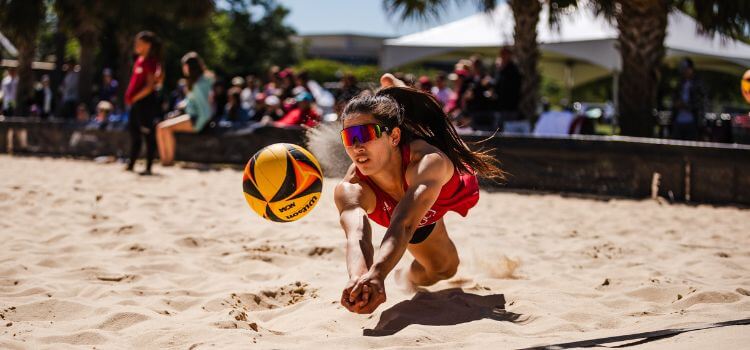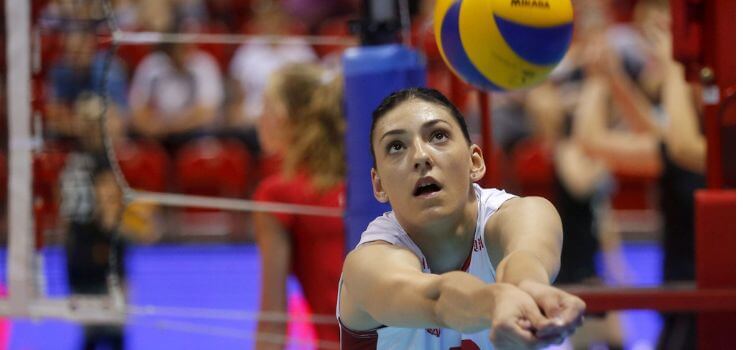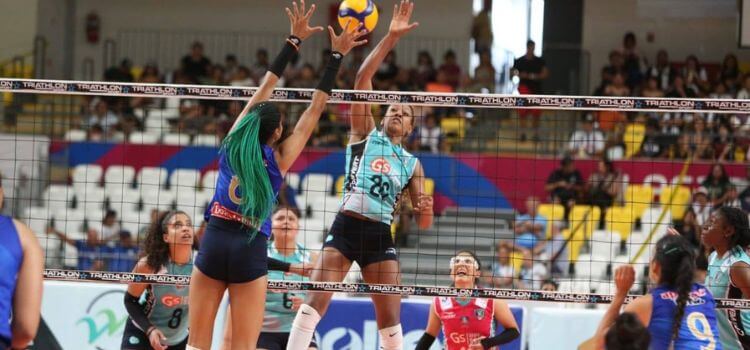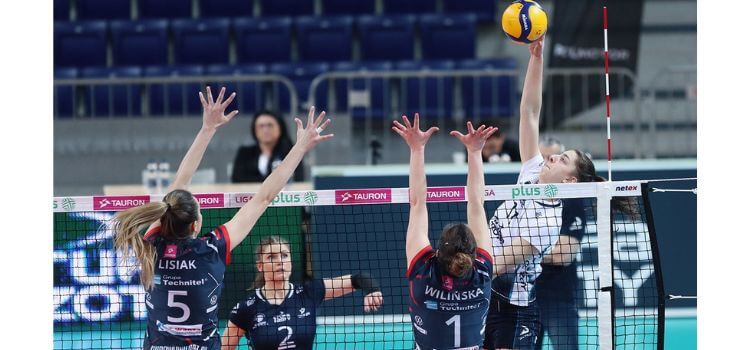As an Amazon Associate, I earn from qualifying purchases
Volleyball ignites with the thunderous crack of a powerful spike. But how do we measure the effectiveness of these offensive attacks? Enter the realm of statistics, where two key metrics reign supreme: hitting percentage and kill percentage.
Both offer valuable insights into an attacker’s performance, but they paint distinct pictures. This comprehensive guide delves into the intricacies of each statistic, exploring their formulas, interpretations, limitations and mainly we express Volleyball Hitting Percentage vs. Kill Percentage.
We’ll equip you to differentiate between hitting efficiency and pure offensive dominance, ultimately empowering you to analyze and optimize attacking prowess in the captivating world of volleyball
Dominating the Net: Why Understanding Attacking Efficiency Matters
Volleyball, a sport of intense rallies and electrifying spikes, thrives on offensive prowess. Attackers at the net unleash powerful swings, aiming to overpower the opposing defense and score points.
Read More The Best Volleyball Clubs in Chicago:100 list
But how do we measure their effectiveness? Enter two key statistics: hitting percentage and kill percentage. Both offer valuable insights into an attacker’s performance, but they paint slightly different pictures.
Hitting Percentage: Accounting for Success and Blunders
Hitting percentage, also known as attack efficiency, provides a holistic view of an attacker’s performance. It takes into account both their successful attacks (kills) and their unsuccessful attempts (errors). Here’s the formula:
Hitting Percentage = (Kills – Errors) / Total Attempts
Here is a table summarizing the performance of the outside hitters in men’s volleyball during the Tokyo Olympics, including hitting percentage, kill percentage, and error percentage:
| Team | Player Name | Hitting % | Hit % Rank | Kill % | Kill % Rank | Error % | Err % Rank |
|---|---|---|---|---|---|---|---|
| Poland | Wilfredo Leon | 0.477 | 1 | 57.0% | 1 | 9.4% | 3 |
| Italy | Osmany Juantorena | 0.464 | 2 | 54.2% | 5 | 7.8% | 1 |
| Canada | Gordan Perrin | 0.438 | 3 | 54.5% | 4 | 10.7% | 4 |
| USA | Taylor Sander | 0.415 | 4 | 55.1% | 2 | 13.6% | 6 |
| Italy | Alessandro Michieletto | 0.396 | 5 | 48.1% | 11 | 8.4% | 2 |
| Iran | Meisam Salehi | 0.392 | 6 | 54.6% | 3 | 15.4% | 16 |
| France | Trevor Clevenot | 0.353 | 7 | 52.7% | 6 | 17.4% | 19 |
| Brazil | Ricardo Lucarelli | 0.344 | 8 | 48.9% | 9 | 14.4% | 11 |
| Japan | Yuki Ishikawa | 0.340 | 9 | 47.1% | 14 | 13.1% | 5 |
| USA | TJ Defalco | 0.331 | 10 | 48.1% | 12 | 15.0% | 15 |
| France | Earvin Ngapeth | 0.329 | 11 | 50.4% | 7 | 17.5% | 20 |
| Brazil | Leal | 0.320 | 12 | 46.2% | 16 | 14.2% | 10 |
| Russia | Egor Kliuka | 0.317 | 13 | 46.4% | 15 | 14.8% | 13 |
| Argentina | Facundo Conte | 0.304 | 14 | 44.8% | 18 | 14.4% | 12 |
| Argentina | Cristian Poglajen | 0.302 | 15 | 49.1% | 8 | 18.9% | 15 |
Read More: Best Volleyball Knee Pads Reddits 100%
This table captures the key statistics for each player, helping to compare their performance during the Tokyo Olympics.
The table summarizing the performance of outside hitters in men’s volleyball during the Tokyo Olympics, focusing on hitting percentage with a minimum of 50 attempts:
| Team | Player Name | Kills | Errors | Total Attacks | Hitting % | Hitting % Rank |
|---|---|---|---|---|---|---|
| Poland | Wilfredo Leon | 85 | 14 | 149 | .477 | 1 |
| Italy | Osmany Juantorena | 97 | 14 | 179 | .464 | 2 |
| Canada | Gordan Perrin | 66 | 13 | 121 | .438 | 3 |
| USA | Taylor Sander | 65 | 16 | 118 | .415 | 4 |
| Italy | Alessandro Michieletto | 74 | 13 | 154 | .396 | 5 |
| Iran | Meisam Salehi | 71 | 20 | 130 | .392 | 6 |
| France | Trevor Clevenot | 106 | 35 | 201 | .353 | 7 |
| Brazil | Ricardo Lucarelli | 88 | 26 | 180 | .344 | 8 |
| Japan | Yuki Ishikawa | 90 | 25 | 191 | .340 | 9 |
| USA | TJ Defalco | 64 | 20 | 133 | .331 | 10 |
| France | Earvin Ngapeth | 124 | 43 | 246 | .329 | 11 |
| Brazil | Leal | 91 | 28 | 197 | .320 | 12 |
| Russia | Egor Kliuka | 85 | 27 | 183 | .317 | 13 |
| Argentina | Facundo Conte | 112 | 36 | 250 | .304 | 14 |
| Argentina | Cristian Poglajen | 26 | 10 | 53 | .302 | 15 |
This table lists the kills, errors, total attack attempts, hitting percentage, and the rank for hitting percentage for each player.
Read More : Kill Percentage Volleyball
Understanding the Components: Volleyball Hitting Percentage vs. Kill Percentage
Kills: These are attacks that result in a point for the attacking team. They can occur when the opponent fails to dig the ball (a successful defensive reception), commits a blocking error, or the attack forces the opponent to hit the ball out of bounds.
Errors: These are unsuccessful attacks. They include hitting the ball out of bounds, hitting the net, or having the attack successfully blocked by the opponent.
People also Ask How to Calculate Hitting Percentage in Volleyball
Total Attempts: This represents every time the attacker attempts to hit the ball over the net, regardless of the outcome.
Interpreting Hitting Percentage:
A higher hitting percentage indicates a more efficient attacker. Generally, a percentage above .300 is considered good, signifying that the attacker is generating more kills than errors. A percentage below .100 implies a struggle to convert attacks into points. However, hitting percentage has limitations:
Doesn’t Reflect Shot Selection: A smart attacker might choose strategic “tips” or “dinks” instead of swinging for a kill. These controlled shots lower the hitting percentage even though they might be tactically sound.
People also ask : How to Inflate Volleyball
Doesn’t Account for Difficulty: Hitting against a strong block or a skilled defensive team naturally increases the likelihood of errors.
Kill Percentage: A Laser Focus on Offensive Domination
Kill percentage takes a more narrow approach, solely focusing on the attacker’s ability to convert attempts into kills. Here’s the formula:
Kill Percentage = Kills / Total Attempts
Decoding Kill Percentage:
A high kill percentage indicates a potent attacker who consistently overpowers the defense. Players with percentages exceeding .400 are considered exceptional offensive threats. However, similar to hitting percentage, kill percentage has its limitations:
People also ask Best Volleyball gifts for guys
Ignores Errors: It doesn’t account for unsuccessful attempts, which can provide valuable insights into an attacker’s consistency and risk-taking tendencies.
Doesn’t Consider Shot Selection: Just like hitting percentage, strategic tips and dinks are not reflected, potentially underestimating the attacker’s tactical contribution.
Volleyball Hitting Percentage vs. Kill Percentage: When to Use Which

Now that we understand both statistics, let’s explore when each one is most useful:
Use Hitting Percentage When:
You want a comprehensive picture of an attacker’s efficiency, including both successful kills and unsuccessful attempts.
You want to compare attackers playing against teams with varying defensive strengths.
People also ask Best Volleyball gifts for guys
You’re evaluating a player’s ability to adjust their attack strategy based on the situation.
Use Kill Percentage When:
You’re primarily interested in an attacker’s pure offensive firepower and ability to overpower the defense.
You’re scouting for attackers who consistently convert attacks into points.
You’re comparing attackers playing against teams with similar defensive capabilities.
The Perfect Blend: Combining Stats for a Well-Rounded Analysis
A truly insightful analysis doesn’t rely solely on hitting percentage or kill percentage. The best approach is to consider both statistics in conjunction with other volleyball metrics, such as:
People aslo ask Why do liberos wear a different jersey: The Standout Specialist
Blocking: A strong blocking team can significantly impact an attacker’s hitting percentage.
Setting: A setter’s ability to provide accurate and well-timed sets can drastically influence an attacker’s success.
Serving: Effective serving can disrupt the opponent’s reception, leading to easier attacks and potentially boosting an attacker’s kill percentage.
By combining hitting percentage and kill percentage with other relevant data, coaches and analysts gain a more nuanced understanding of an attacker’s performance and how they contribute to their team’s offensive success.
Beyond the Numbers: The Art of Attacking
While statistics play a crucial role, volleyball is a dynamic sport with a strong element of human intuition and strategy. A skilled attacker possesses more than just a powerful swing.
Read More: What is the difference between beach volleyball and indoor volleyball
The Art of Attacking: Beyond the Numbers
Here are some key qualities that differentiate exceptional attackers from the rest:
Shot Selection: The ability to read the defense and choose the most effective attack for the situation, whether it’s a forceful kill, a tactical dump shot, or a well-placed angle.
Versatility: Being able to adjust their attack based on the setter’s location, the opponent’s block, and the game situation.
Read More: 20 Best Youth Volleyball Knee Pads : Reviewed
Footwork and Approach: Powerful and controlled footwork allows for a smooth transition into the jump and a strong, efficient swing.
Hand Technique: Proper hand positioning and contact with the ball are crucial for generating power and accuracy.
Mental Toughness: Maintaining composure under pressure and consistently delivering in high-stakes situations.

Optimizing Attacking Performance: Tips for Players and Coaches
For Players:
Practice Shot Selection: Work on drills that simulate different game situations and require choosing between various attacking options.
Read More : Why 22 Best Beach Volleyball Swimsuits: you need to Know?
Develop Versatility: Expand your attacking repertoire by practicing different types of shots, including tips, dinks, and line shots.
Refine Footwork and Approach: Focus on drills that improve your explosiveness, jumping technique, and approach consistency.
Master Hand Technique: Work with a coach to ensure proper hand positioning and contact for optimal power and control.
Stay Mentally Tough: Practice visualization techniques and mental conditioning exercises to build resilience under pressure.
For Coaches: Volleyball Hitting Percentage vs. Kill Percentage
Design Drills for Shot Selection: Create practice scenarios that replicate real-game situations and require players to make decisions about attacking options.
Emphasize Versatility: Integrate drills that involve practicing diverse attacking techniques beyond just powerful kills.
Read More: Best Used Volleyball Training Equipment
Analyze Footwork and Approach: Identify areas for improvement in players’ footwork and approach technique. Provide targeted drills and feedback to enhance efficiency.
Focus on Hand Technique: Conduct drills that emphasize proper hand positioning and contact for maximizing offensive power and accuracy.
Develop Mental Fortitude: Incorporate mental conditioning exercises and strategies into your training regimen to build mental toughness in your players.
The Final Spike: Volleyball Hitting Percentage vs. Kill Percentage
Understanding hitting percentage and kill percentage is a valuable tool for analyzing attacking performance in volleyball. However, these statistics should be interpreted alongside other metrics and player qualities for a comprehensive evaluation.
Read More Professional Volleyball Net Set: A Guide to the Best 10 Brands
By combining statistical analysis with a focus on player development and strategic decision-making, coaches and players can unlock the full potential of their attacking prowess, leading to a more dominant and successful presence on the court.
Advanced Statistics: Explore more complex metrics like hitting efficiency adjusted for blocking (HAA) or offensive rating (OR) for an even deeper dive into attacker performance.
League Variations: Be aware that some leagues might have slightly different ways of calculating hitting and kill percentages. Ensure you understand the specific formulas used in the context you’re analyzing.
The Future of Analytics: Technological advancements are constantly introducing new tools for tracking and analyzing player performance. Stay tuned for future developments in volleyball analytics that might provide even more insightful data about attacking efficiency.
By staying informed and continuously seeking knowledge, you can become an expert in evaluating and optimizing offensive strategies in volleyball.
Conclusion
Understanding hitting percentage and kill percentage equips you with powerful tools to analyze and optimize attacking efficiency in volleyball.
Remember, these statistics are valuable starting points, but the true magic lies in the art of attacking itself. By honing your technical skills, sharpening your strategic mind, and cultivating unwavering mental toughness, you can transform into a dominant force on the court.
Read More : Plus Size Volleyball Knee Pads: 100 Reviewed
So, keep practicing, embrace the challenge, and unleash your inner spiker!
Frequently Asked Questions (FAQs)
This section addresses some common questions regarding hitting percentage and kill percentage:
Q: What is a good hitting percentage in volleyball?
A: A hitting percentage above .300 is generally considered good. However, this can vary depending on the level of play, the strength of the opponent, and the role of the attacker within the team’s strategy.
Q: What is a good kill percentage in volleyball?
A: A kill percentage exceeding .400 is considered exceptional. Similar to hitting percentage, this benchmark can be influenced by various factors.
Q: Which is more important: hitting percentage or kill percentage?
A: There’s no single answer. Hitting percentage provides a broader picture, while kill percentage focuses on pure offensive power. The best approach is to consider both statistics along with other relevant data points. Read More:Volleyball for 5-Year-Olds Near Me
Q: How can I improve my hitting percentage?
A: Focus on practicing shot selection, developing versatility in your attacks, refining your footwork and approach, mastering hand technique, and staying mentally strong.
Q: How can I improve my kill percentage?
A: Work on increasing your hitting power and accuracy through drills that target explosiveness, proper hand positioning, and efficient swing mechanics. Analyze your shot selection strategies to ensure you’re maximizing opportunities for successful kills.
The Final Word: Unleashing Your Inner Spiker
By delving into the intricacies of hitting percentage and kill percentage, you’ve gained valuable knowledge to assess and elevate attacking performance in volleyball. Remember, statistics are just a starting point.
The true mastery of attacking lies in the combination of technical skill, strategic thinking, and unwavering determination. So, step onto the court with confidence, unleash your inner spiker, and dominate the net!

